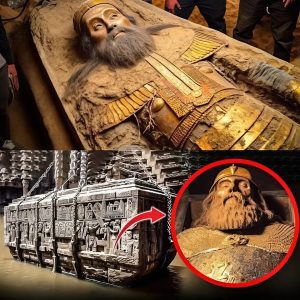The world of archaeology is filled with mysteries that challenge our understanding of history. From ancient artifacts with unknown origins to structures that defy logic, these discoveries have puzzled experts for decades. Here are the top 10 unexplained archaeological discoveries that continue to baffle researchers and ignite the imagination.

1. The Antikythera Mechanism: An Ancient Computer
Discovered in 1901 off the coast of the Greek island Antikythera, this complex, clockwork-like device dates back to around 100 BC. The Antikythera Mechanism is believed to have been used to predict astronomical positions and eclipses. However, its intricate design suggests a level of technological sophistication that wasn’t thought to exist in the ancient world. How did such an advanced device come to be? The origins of this ancient “computer” remain one of archaeology’s greatest mysteries.
2. The Nazca Lines: A Message from the Skies?
Etched into the desert floor of southern Peru, the Nazca Lines are a series of massive geoglyphs depicting animals, plants, and geometric shapes. Some of these drawings stretch over 1,200 feet long and are best viewed from the air. The purpose of these lines, created between 500 BC and 500 AD, is still unknown. Were they part of religious rituals, an astronomical calendar, or perhaps a message to extraterrestrials? The true meaning behind the Nazca Lines remains elusive.

3. The Piri Reis Map: Evidence of Ancient Knowledge?
The Piri Reis Map, created in 1513 by the Ottoman admiral Piri Reis, is one of the most controversial maps in history. It depicts parts of Europe, Africa, and South America with remarkable accuracy, long before these regions were thoroughly explored by European navigators. What’s even more perplexing is that it seems to show Antarctica free of ice, centuries before the continent was officially discovered. How did the creator of this map have access to such detailed knowledge? The origins of the Piri Reis Map continue to mystify scholars.
4. Gobekli Tepe: The World’s Oldest Temple
Gobekli Tepe, located in modern-day Turkey, is considered the world’s oldest known temple, dating back to around 9600 BC. The site features massive stone pillars arranged in circles, many of which are intricately carved with animal figures. What puzzles archaeologists is how this complex structure was built by a civilization that had yet to develop farming or pottery. Gobekli Tepe suggests that organized religion and monumental architecture existed far earlier than previously believed, but the purpose and creators of this temple remain unknown.
5. The Voynich Manuscript: An Unbreakable Code
The Voynich Manuscript is a mysterious, undeciphered book filled with strange illustrations and text written in an unknown language. Discovered in 1912, it has been carbon-dated to the early 15th century. Despite the efforts of countless cryptographers, linguists, and codebreakers, the manuscript’s meaning remains a complete enigma. Is it a medical treatise, a book of alchemy, or something entirely different? Until the code is cracked, the Voynich Manuscript will continue to intrigue and perplex.
6. The Baalbek Stones: Giants of Ancient Engineering
In the ancient city of Baalbek, Lebanon, lie some of the largest stone blocks ever quarried and used in construction. Known as the Baalbek Stones, these massive blocks, some weighing over 1,000 tons, were used in the foundation of the Temple of Jupiter. How these stones were transported and precisely placed by ancient builders is a mystery that defies modern engineering capabilities. Who were the engineers behind this colossal project, and what was their purpose?
7. The Shroud of Turin: A Holy Relic or Medieval Hoax?
The Shroud of Turin is a piece of cloth that bears the faint image of a man, believed by many to be Jesus Christ. The shroud has been a subject of intense debate for centuries. Radiocarbon dating suggests it dates from the medieval period, yet the technology required to create such an image without the use of pigments or dyes was not available at that time. Is the shroud a genuine relic of Christ, or an elaborate medieval forgery? The true nature of the Shroud of Turin remains one of history’s greatest mysteries.
8. The Baghdad Battery: An Ancient Electrical Device?
The Baghdad Battery, discovered in Iraq and dating back to around 250 BC, is a small clay jar with a copper cylinder and an iron rod. When filled with an acidic liquid, it produces a small electrical current. But why would an ancient civilization need such a device? Some theories suggest it was used for electroplating, while others believe it had a religious or medical purpose. The true function of the Baghdad Battery continues to baffle historians.
9. The Crystal Skulls: Artifacts of a Lost Civilization?
Crystal skulls are intricately carved human skulls made from clear or milky quartz. The most famous of these is the Mitchell-Hedges skull, allegedly discovered in a Mayan temple in Belize in the 1920s. Some believe the skulls possess mystical powers and are relics of a lost civilization, while others think they were created in the 19th century as part of a hoax. Despite modern testing, the origins and purpose of these crystal skulls remain a subject of debate and intrigue.
10. The Oak Island Money Pit: A Treasure Hunt Gone Cold
Located on Oak Island in Nova Scotia, Canada, the Money Pit is a site where treasure hunters have been digging for over 200 years, searching for a mysterious and elusive treasure. Discovered in 1795, the pit is said to contain layers of wooden platforms, booby traps, and artifacts, but no definitive treasure has ever been found. Is the Money Pit a massive hoax, or does it conceal a treasure of unimaginable value? The search continues, but the mystery remains unsolved.
The Enigmas That Endure
These unexplained archaeological discoveries serve as a reminder that the past holds many secrets, waiting to be uncovered. Each of these mysteries challenges our understanding of ancient civilizations and invites us to consider the possibility that there is still much we don’t know about the world’s history. As technology advances and new methods of investigation emerge, perhaps one day these enigmas will be solved. Until then, they continue to captivate and inspire, fueling the imagination of scholars and adventurers alike.





